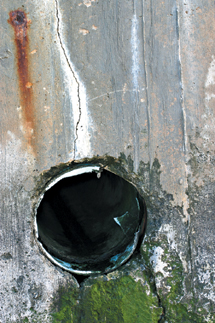Sigma’s EM-140 DG Flash
Lord Of The Rings
Photos © 2004, George Schaub, All Rights Reserved
If you enjoy exploring the fascinating world of close-up photography you should consider a ring flash as an essential part of your creative kit. A ring flash mounts around your taking lens and eliminates problems associated with standard shoe-mount flash and even off-camera flash, mainly the inability to down-angle the flash sufficiently to light the subject properly. It also eliminates the problem of shadowing caused by your body or rig because with a ring flash whatever you see through the lens will get all the light you need.
 |
||
 |
 |
|
|
||
I recently had the opportunity to work with Sigma's new EM-140 DG ringlight flash, a dual-tube affair that comes with adapters for mounting around a 55mm and 58mm lens, with optional adapters up to and including 77mm. The advantage of having two flash tubes, on opposite sides of the unit, is that you can create modeling by using one or the other tube for firing, or have both fire in equal (for flat illumination) power or control the output of each via power-ratio controls. The ability to work with asymmetrical output gives you a lot more creative control. Normally the Guide Number (GN) output is 46 (ISO 100/ft) but dropping down to 1/2 power output, for example, on one side makes the GN for that side 33, and going to 1/16 power makes the GN 12. In addition, this new flash works with the latest flash metering exposure control systems, in my case with Canon's E-TTL II on the Canon EOS Digital Rebel. The unit also works with Nikon, Minolta, Pentax, and of course Sigma cameras with advanced flash systems as well. Check the Sigma website for full compatibility information. For those who previously had trouble with getting proper close-up flash exposures this unit will solve the problem.
 |
 |
||
|
|
The EM-140 DG has two connected parts--the controller, which fits into your hot shoe, and the flash itself, which easily mounts over the lens. For this test Sigma kindly loaned me their 50mm f/2.8 EX DG Macro lens, which allowed me to focus as close as a bit over 1/2 ft with a reproduction ratio of 1:1, if desired. Getting this close with any other flash setup is nearly impossible. Made for macro, this lens also can be stopped down to f/32 or even f/45, depending on the camera in use, a real boon to getting sharpness in close quarters. It also has a focus delimiter, which helps when you are working close.
 |
|
|
The flash itself has some very useful functions, including an auxiliary light that helps viewing and focusing in tight, dark areas. It offers second curtain sync, FP flash (with certain models with advanced flash systems), FE lock, flash exposure compensation, flash bracketing, and multi-flash mode. You can also use it wirelessly if you use Sigma's EF-500 DG Super with a camera that supports that function. In short, this is a ringlight for today's advanced cameras, although it can, with certain limitations, be used with just about any 35mm SLR you might own.
Technical Specifications
Sigma's EM-140 DG Ring Flash
Power: Four AA alkaline, Ni-MH, or NiCd
Guide Number: 46 (ISO 100/ft)
Street Price: About $350

 Sigma's
50mm f/2.8 EX DG Macro Lens
Sigma's
50mm f/2.8 EX DG Macro Lens
Minimum Aperture: f/32 (f/45 for Canon, Minolta AF)
Minimum Focusing Distance: 0.62 ft
Filter Size: 55mm
Street Price: About $249
For more information, visit Sigma's website at: www.sigma-photo.com.
- Log in or register to post comments

































